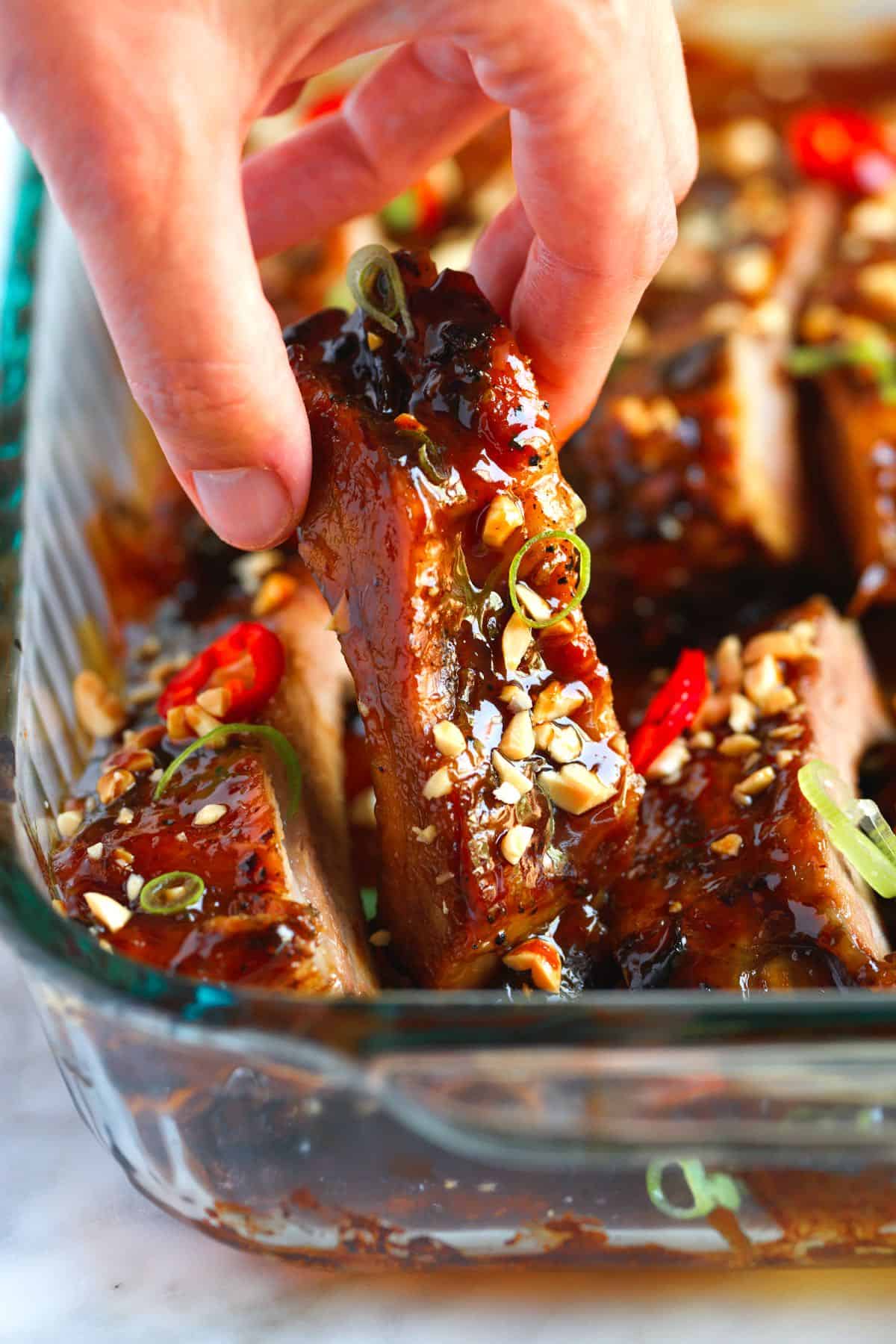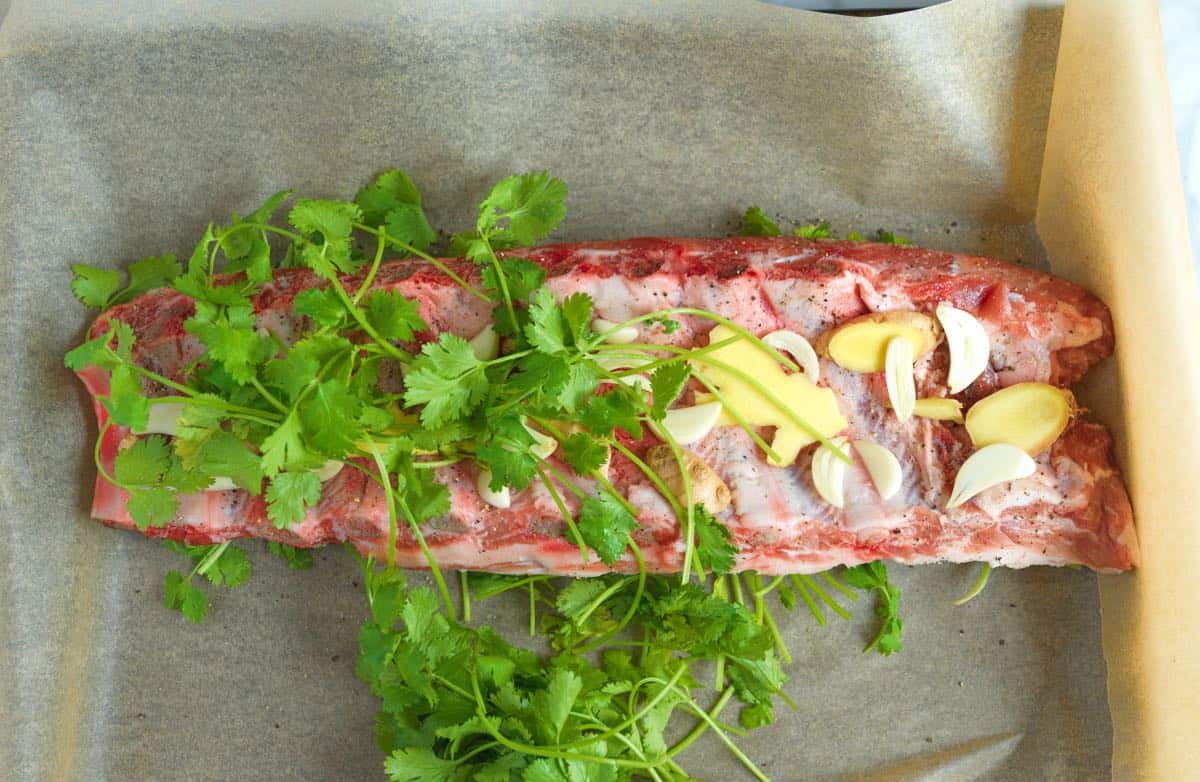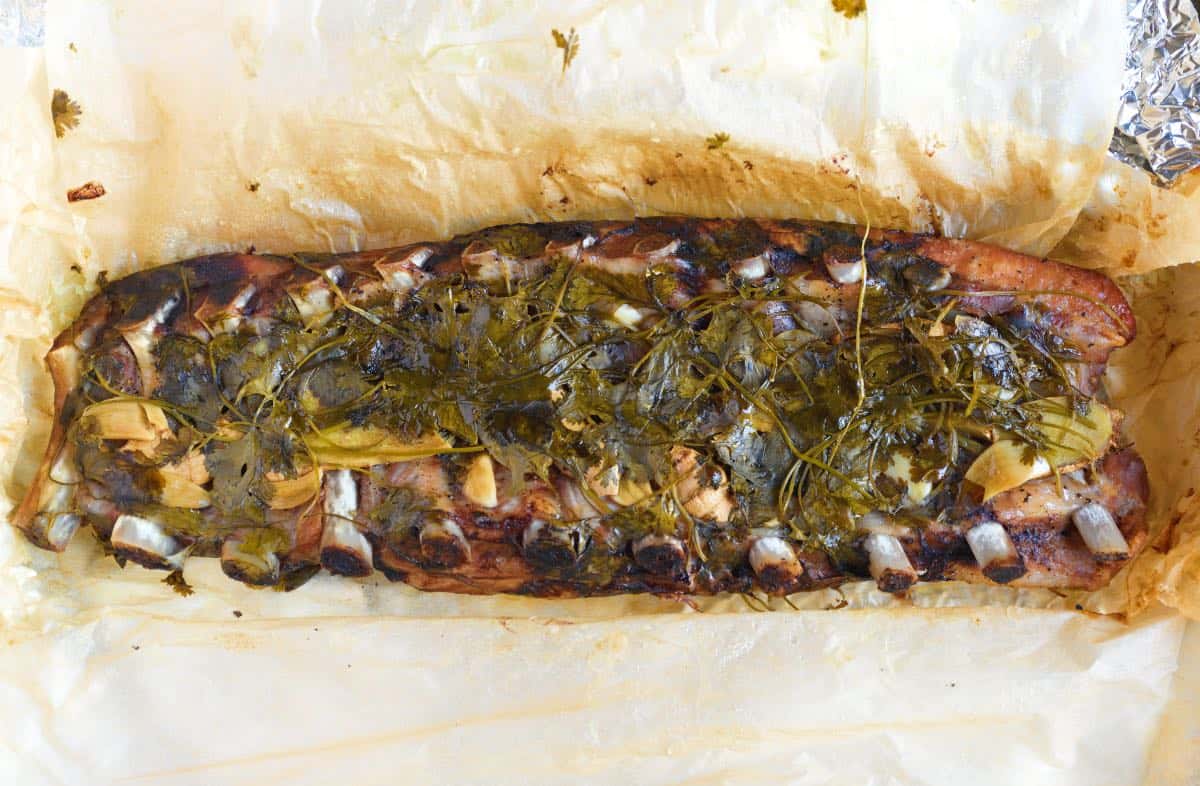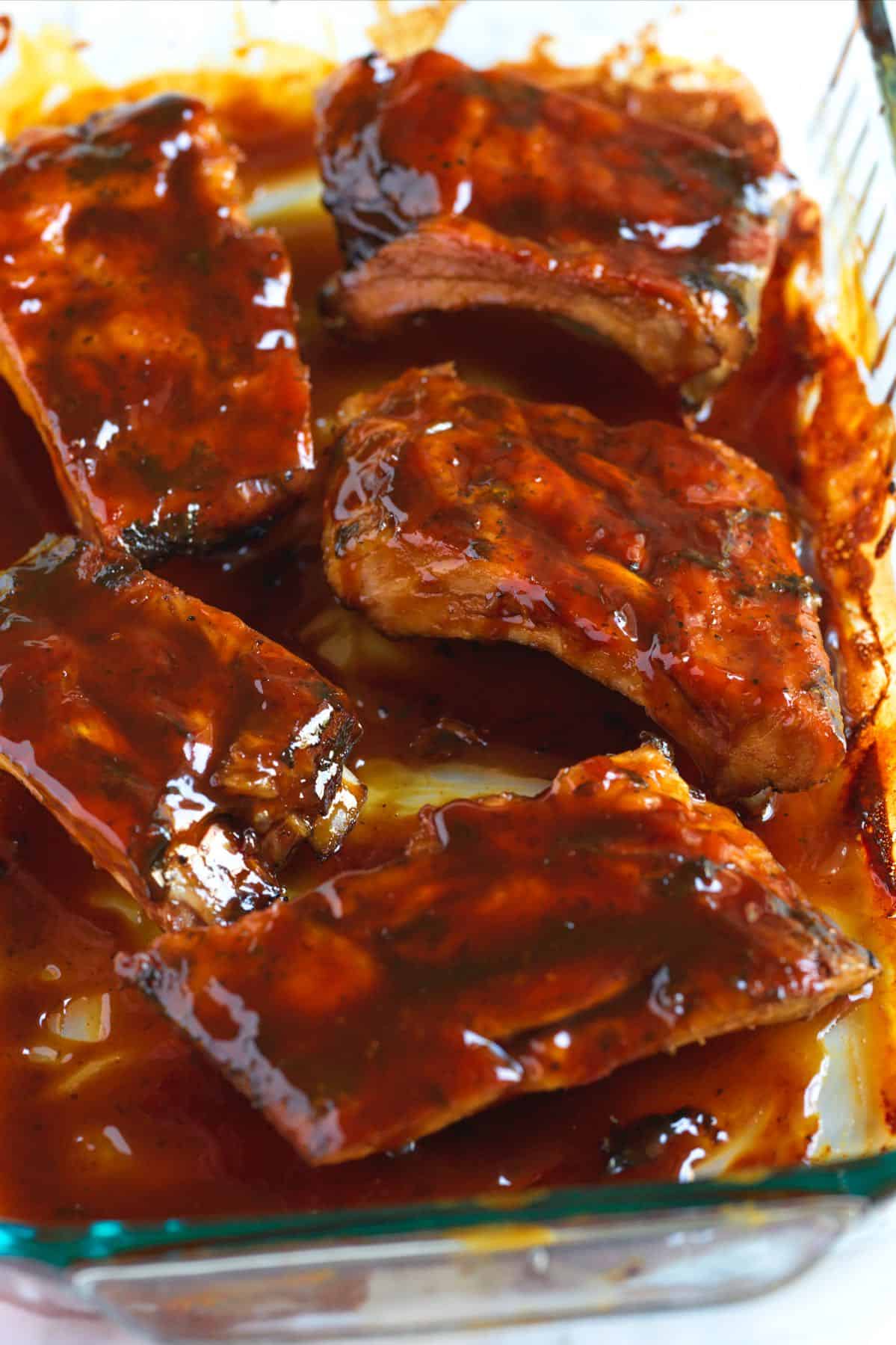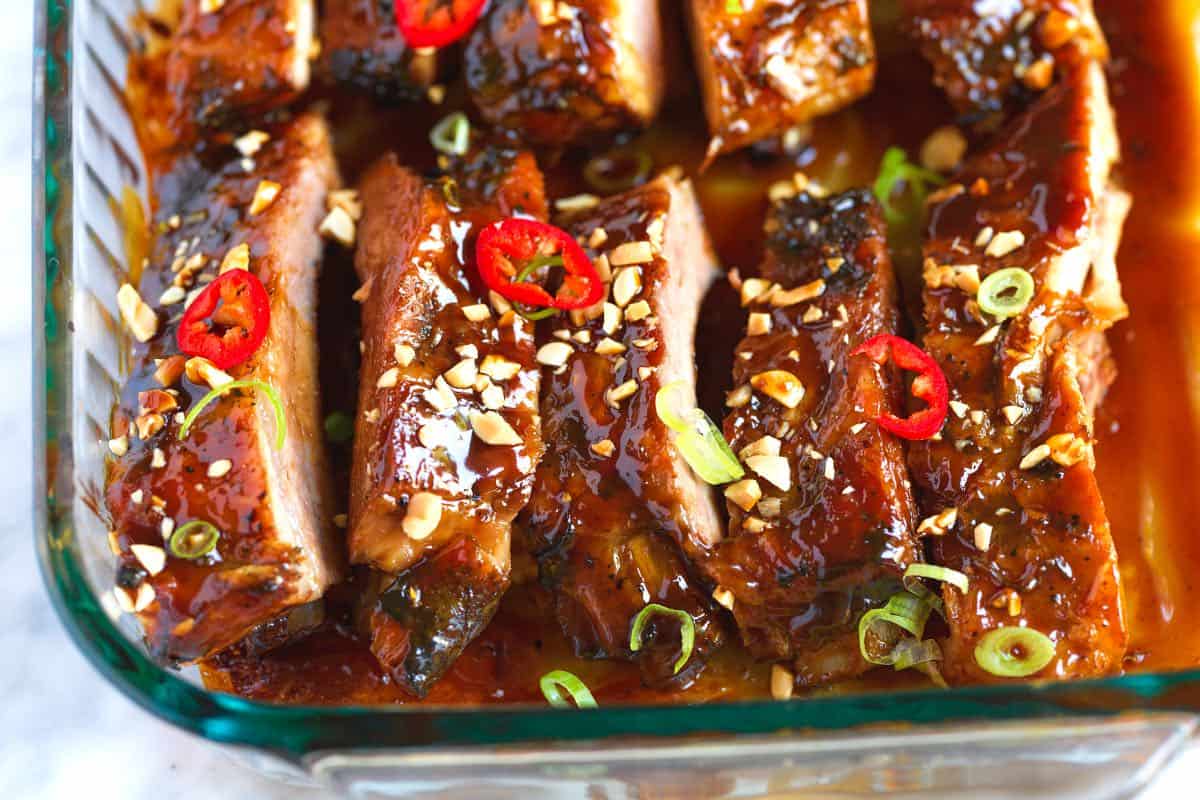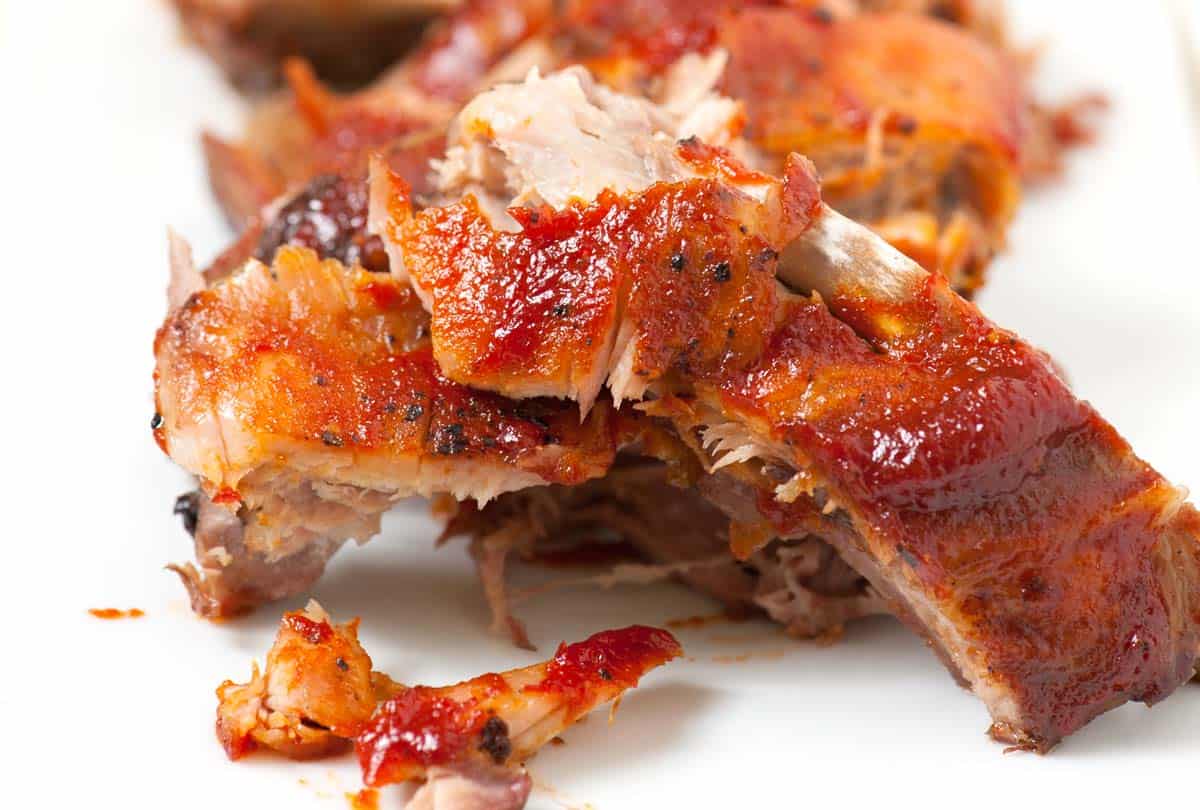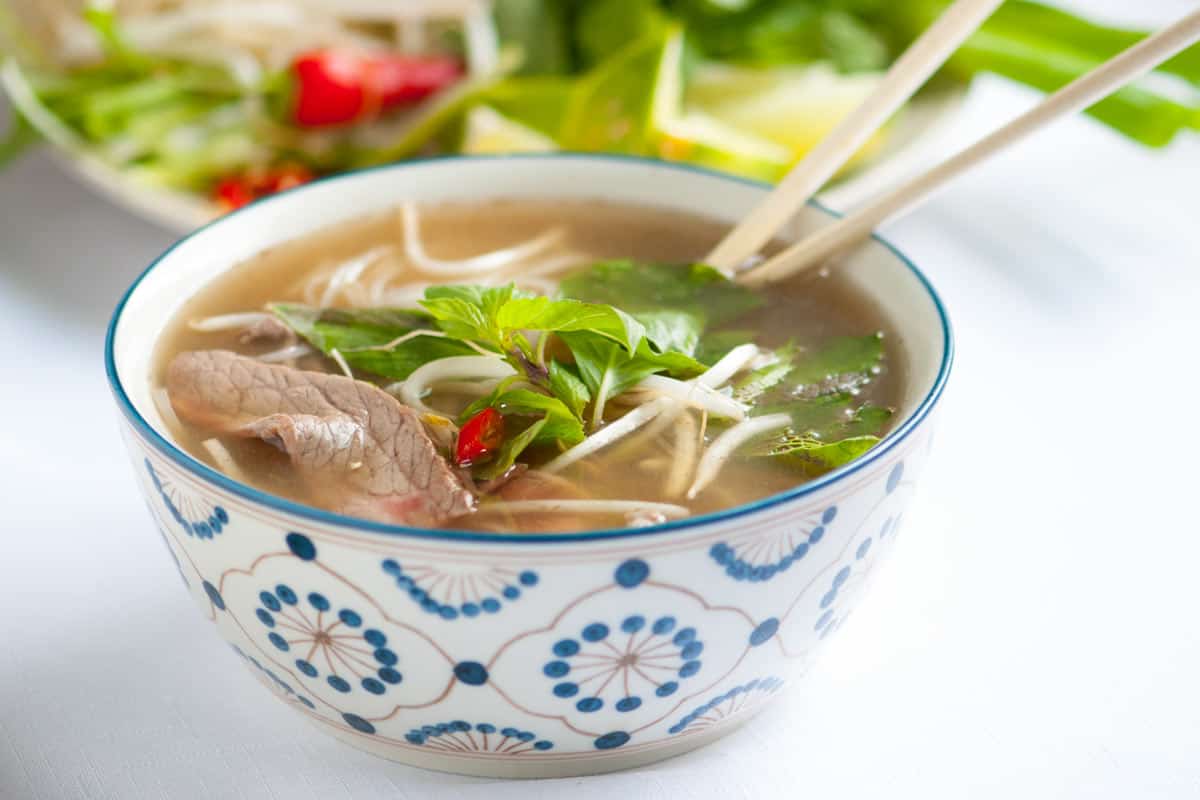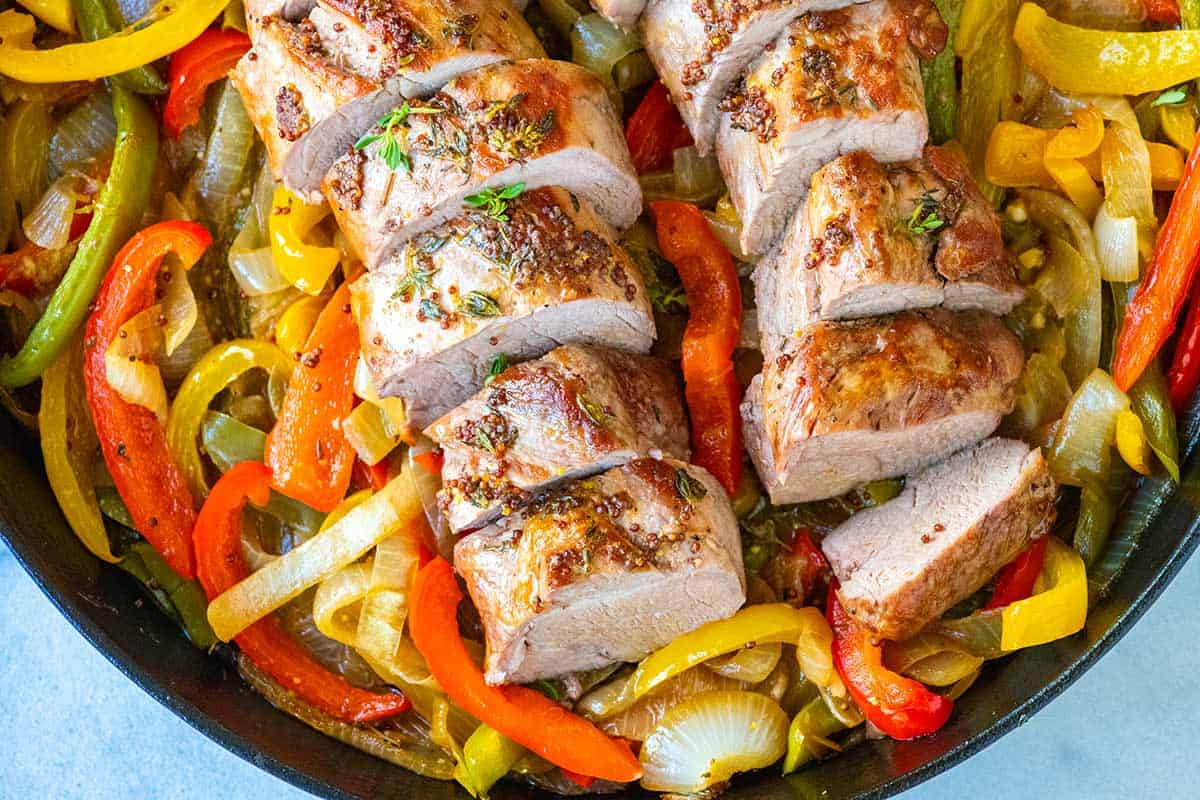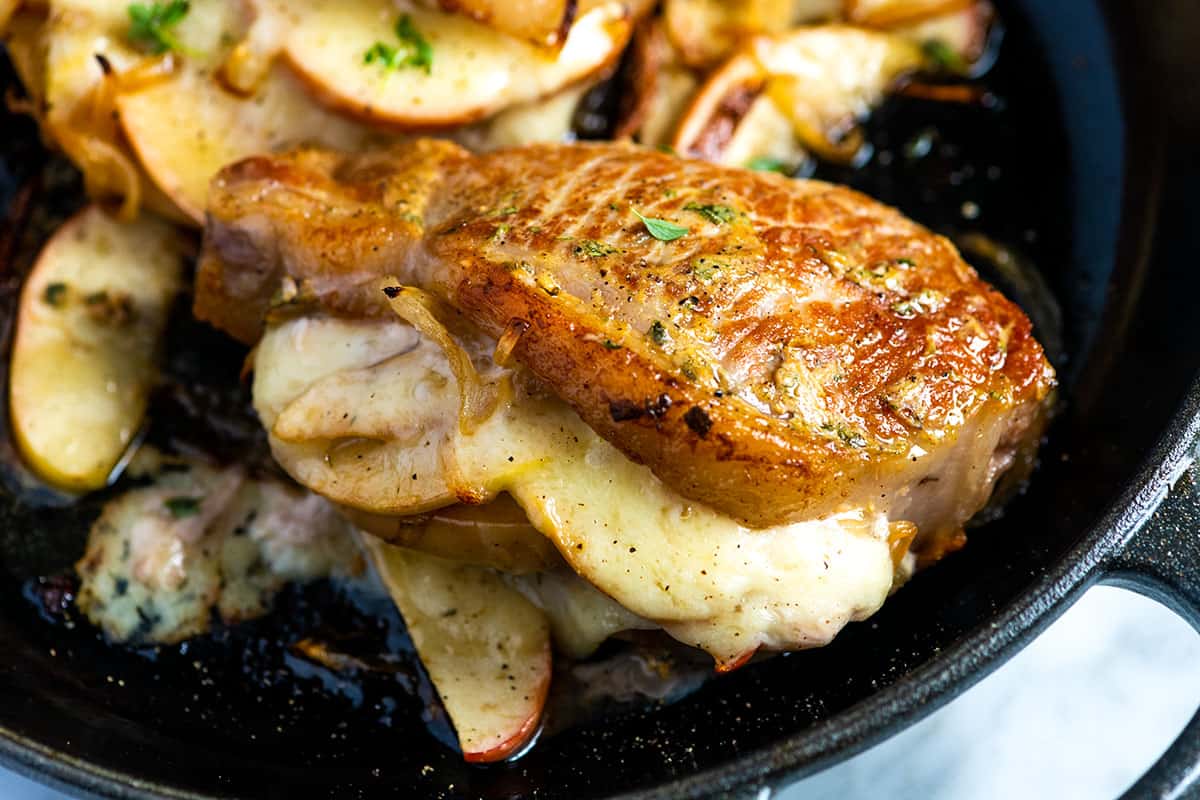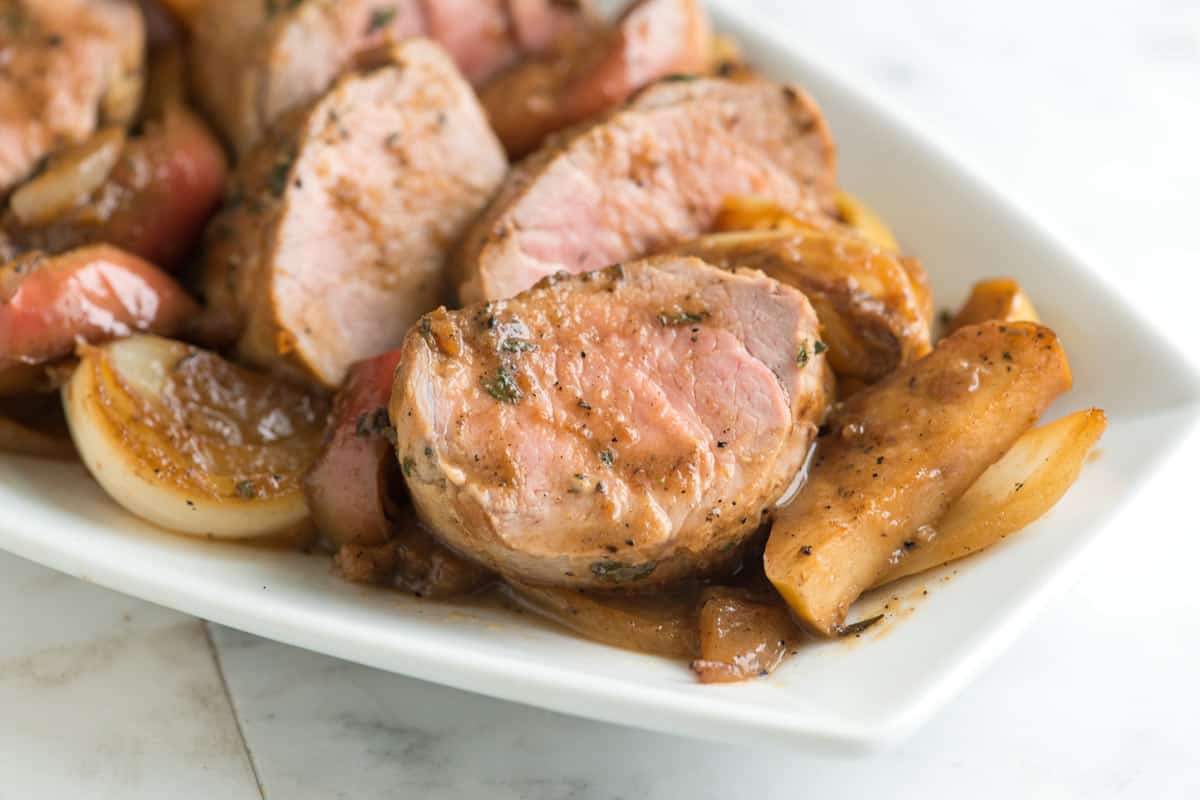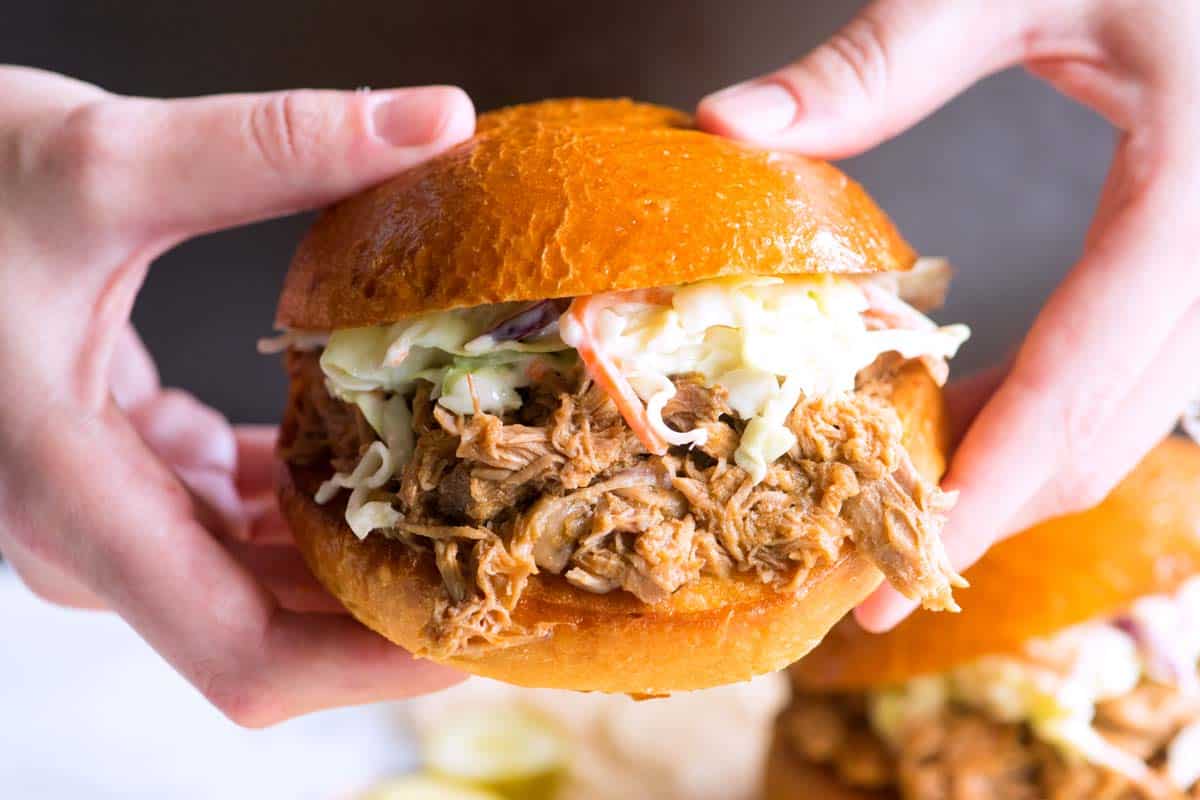These Asian sticky ribs are amazing. Every time we make them, we immediately want to make them again. The ribs are slowly baked in the oven with ginger, garlic, and cilantro to become incredibly tender and infused with flavor. Then, we slather over our homemade hoisin sauce to make the sticky glaze. These are outrageously good.
Key Ingredients
Pork ribs: I’ve used baby back ribs in my photos and video, but you can use baby back, spare ribs, or St. Louis-style ribs in the recipe below. Hoisin sauce: I highly recommend using our easy hoisin sauce, which I have included in the recipe below. It’s easy to make and lasts in the fridge for a month. I usually make a double batch and use it to make these chicken lettuce wraps. Garlic, ginger, and cilantro: For this recipe, we slowly bake our ribs in the oven and love to sneak in some aromatics that slowly infuse the ribs with flavor. Toppings: These are optional, but I love them. I add chopped peanuts, sliced green onion, and sliced red chilies to the ribs for serving.
How to Make Asian Sticky Ribs
I love baking ribs low and slow. We already have this baked ribs recipe on Inspired Taste with over 700 happy reviews. These sticky ribs have a similar baking method, guaranteeing tender, almost falling-off-the-bone ribs! For this recipe, I place the ribs on top of fresh sliced ginger, garlic, and cilantro, then carefully wrap parchment paper around them to create a snug packet. Then, I wrap it once more with foil to really make sure that it is well sealed. As the ribs bake to perfection, they transform, becoming unbelievably tender and infused with ginger, garlic, and cilantro. They bake for 2 to 3 hours. Once the ribs are baked and rested, I unwrap them and generously coat them in our homemade hoisin sauce. Then, they return to a hot oven where the sauce bubbles, reduces, and transforms into a delicious sticky glaze. We worked on this recipe with Chef Richard Hattaway and had an absolute blast! Honestly, we might have indulged in a few extra taste tests along the way (haha). These ribs are so incredibly delicious.
Make Ahead Sticky Ribs
You can make these Asian ribs 3 days ahead of time. After baking them, wrap them and store them in the refrigerator. Then, when ready to serve, unwrap the ribs and add the hoisin sauce. Finally, bake the ribs in a hot oven until heated through and the sauce becomes sticky.
What to Serve with Sticky Ribs
I love these sticky ribs and serve them with rice, coconut rice, or noodles for dinner. They are also amazing next to fried rice. I also love adding something fresh and crunchy. Try our cilantro lime slaw, garlic green beans, or this cucumber and avocado salad. You can also serve them with spring rolls, egg rolls, homemade crab Rangoon, or this spicy ginger edamame. 1 cup homemade hoisin sauce, recipe below 8 cloves garlic, peeled and thinly sliced Two 1-inch thumb-size pieces of fresh ginger, sliced thin lengthwise Half a bunch of fresh cilantro Salt and pepper 2 tablespoons finely chopped peanuts, optional 1 Fresno chili pepper, thinly sliced, optional 1 green onion, finely chopped, optional 2 cloves garlic, finely minced or grated One 1-inch thumb-size piece fresh ginger, finely minced or grated 2 green onions, whites and light green parts only, finely minced 5 tablespoons (65 grams) light tamari or light soy sauce, plus more to taste 5 tablespoons (65 grams) pure maple syrup 2 tablespoons (30 grams) molasses 1 tablespoon (20 grams) peanut butter, try homemade peanut butter 1 ½ teaspoons Gochujang, see notes 1 teaspoon rice wine vinegar 1/4 teaspoon Chinese Five Spice 1/4 teaspoon cornstarch 2Trim excess fat from the ribs and remove any thin membrane on the back of the rack. (Some ribs may already have the membrane removed, I show how to remove it in this ribs recipe). 3Pat the ribs dry and season them with salt and pepper. 4Take a piece of parchment paper large enough to wrap around the ribs (you may need to overlap two sheets). Spread half of the garlic, ginger, and cilantro on the parchment paper. Place the ribs on top, with the meaty side facing down. Arrange the remaining garlic, ginger, and cilantro on the bone side of the ribs. 5Wrap the parchment paper tightly around the ribs, folding the edges to seal. Then, wrap the entire package with foil. Remember which side has the meatiest part of the ribs. 6Place the wrapped ribs, with the meatiest side facing down, on the prepared baking sheet. 7Bake the ribs in the preheated oven for 2 ½ to 3 hours. Carefully unwrap the ribs and pierce them with a knife to check for tenderness. 8While the ribs are baking, you can make the hoisin sauce using the recipe instructions below. 9Allow the ribs to cool while still wrapped. Let them rest at room temperature, or refrigerate the wrapped package on a baking sheet for up to 3 days. 2Stir in soy sauce, maple syrup, molasses, peanut butter, Gochujang, rice wine vinegar, and the Chinese Five Spice. Return the saucepan to medium heat and, while stirring, slowly bring to a simmer. Taste the sauce and adjust with 1/2 tablespoon to 1 tablespoon of soy sauce if necessary. 3Make a cornstarch slurry by mixing 1/2 teaspoon cornstarch with 2 teaspoons water. Whisk the slurry into the sauce. As it simmers, the sauce will thicken. Once thickened, remove it from the heat and let it cool. 2Gently unwrap the ribs and scrape away the cilantro, garlic, and ginger (these can be discarded). 3Cut the rack into individual ribs or two- to three-bone portions. Place them in a 13-inch by 9-inch baking dish. 4Spoon most of the hoisin sauce over the ribs, ensuring they are well covered (save a little sauce for later). Flip the ribs so the meaty side faces down and move them around in the sauce for even coating. 5Bake the uncovered ribs for 3 to 5 minutes or until the sauce bubbles. 6Remove the baking dish from the oven and flip the ribs so the meaty side faces up. Tilt the baking dish and gather as much sauce as possible to spoon back over the ribs. This time, the sauce will be thicker. At this point, I like to add a little extra sauce on top. 7Serve with chopped peanuts, sliced pepper, and green onion.

